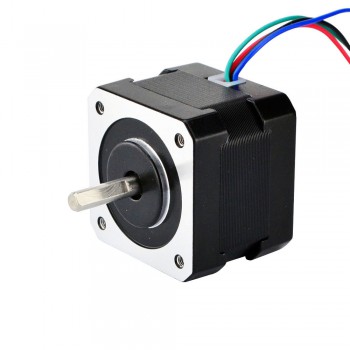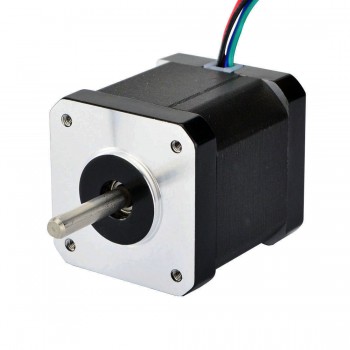| En poursuivant votre navigation sur ce site, vous acceptez l'utilisation de cookies pour vous proposer des services et offres adaptés à vos centres d'intérêt. En savoir plus et gérer ces paramètres. |  |
Blog de tianqiong2019
aide blog-

Reasons for overheating of hybrid stepper motors publié le 20/09/2024 à 10:57
1.What is a hybrid stepper motor
A hybrid stepper motor is a motor that combines the advantages of a permanent magnet stepper motor and a reactive stepper motor. It achieves the complementary advantages of high torque and high precision through a specific structural design, thus providing a high-precision, combined stepper drive. Hybrid stepper motors are divided into two-phase, three-phase and five-phase, of which the two-phase step angle is generally 1.8 degrees, the three-phase step angle is generally 1.2 degrees, and the five-phase step angle is generally 0.72 degrees. The rotor of this motor itself is magnetic, so the torque generated under the same stator current is greater than that of a reactive stepper motor, and its step angle is usually smaller. This makes hybrid stepper motors widely used in occasions that require high-precision control, such as economical CNC machine tools.2.Design ideas for hybrid stepper motors
1.Structural design: The structural design of the hybrid stepper motor combines the advantages of variable reluctance (VR) stepper motors and permanent magnet (PM) stepper motors. Specifically, it adopts the gear-shaped iron core rotor of the VR motor, which can achieve a smaller step angle, and combines the strong permanent magnet of the PM motor to enhance the torque output, achieving the coexistence of miniaturization and high torque. This structural layout optimizes the magnetic field distribution and torque characteristics of the motor, allowing the hybrid stepper motor to provide stronger power output without sacrificing step accuracy.
2.Number of phases and step angles: Hybrid stepper motors are divided into two-phase, three-phase and five-phase, of which the two-phase step angle is generally 1.8 degrees, the three-phase step angle is generally 1.2 degrees, and the five-phase step angle is 0.72 degrees. This design enables the hybrid stepper motor to have a higher step angle resolution and can achieve higher positioning accuracy.3.Operating conditions of hybrid stepper motors
1.Power supply: The hybrid stepper motor needs to be connected to an appropriate power supply to provide the necessary power to drive the motor. The voltage and current of the power supply should meet the specifications of the motor to ensure the normal operation of the motor.
2.Control signal: The operation of the hybrid stepper motor also requires external control signals. These signals are usually generated by a microcontroller or a special stepper motor driver, which controls the number of steps and direction of the motor by changing the direction and size of the current in the coil.
3.Drive circuit: In order to convert the control signal into a drive signal that the motor can understand, a special drive circuit is required. These circuits can change the direction of the current in the coil in a timely manner according to the instructions of the control signal, thereby guiding the motor to rotate according to the preset mode.
4.Reasons for the high temperature of the hybrid stepper motor
1.Excessive current: When the stepper motor is working, if the current setting is too large, it will cause too much heat energy to be generated inside the motor, thereby increasing the temperature. Excessive current may be because the current set by the driver is larger than the rated current of the motor, or because the speed of the stepper motor is too fast, causing the motor to heat up.
2.Improper drive method: The stepper motor needs to be controlled by the driver. If the driver is improperly set, such as excessive current, unreasonable subdivision settings, etc., it will cause the motor to heat up. Improper driving mode will cause the motor to generate additional heat during operation.
3.Long-term operation: If the stepper motor works continuously for too long without proper heat dissipation measures, the heat cannot be dissipated in time, which will cause the temperature to rise. Long-term operation at high voltage or high frequency will also increase the temperature.
4.Magnetic material loss: The magnetic material in the stepper motor will generate additional heat due to hysteresis loss and eddy current loss during operation. These losses are inevitable, but can be reduced by optimizing the design and material selection.
5.High ambient temperature and poor heat dissipation conditions: The temperature of the operating environment is relatively high, the heat dissipation conditions are relatively poor, or the installation contact area does not meet the standards, which will also cause the stepper motor temperature to rise.
6.The working state does not meet the technical requirements: If the three-phase six-beat motor is changed to double three-beat operation, the temperature rise will become higher. This shows that improper adjustment of the working state will increase the temperature rise of the motor.
7.Drive circuit failure: The stepper motor drive circuit fails, and the motor works at a single high voltage or a high frequency for a long time, which also causes the temperature to rise.Source:https://www.stepperyoyo.com/2024/09/reasons-for-overheating-of-hybrid.html
(0) commentaires
ARCHIVES

"Jean-Michel Berille, le responsable des télé-conseillers." |

- Méthode Savoir Maigrir |
|
ACCUEIL
COACHING
|
PREMIUM
FORUM PREMIUM
|
COMMUNAUTÉ
FORUM
|
RUBRIQUES
DOSSIERS
|
GUIDES
PLUS
|
|
||||||
|
|
|
|||||
|
|
||||||
|
|
||||||
|
|
|
|||||
|
|
||||||
|
|
Tags : ventre plat | maigrir des fesses | abdominaux | régime américain | régime mayo | régime protéiné | maigrir du ventre | |
|
|
|
Découvrez aussi : exercices abdominaux | recette wok | |
|
|
|
|
|
ANXA Partenaires : Recette de cuisine | Recette cuisine | |
|



